

Japanese language learning games. Online Japanese Tests. Japanese Study. JLPT N4 Practice Test. So, you’ve studied Japanese for the right amount of study hours you need for the big test.
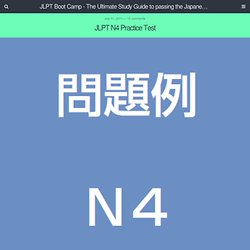
You’ve gone over the kanji and vocabulary, even mastered all the grammar and phrases you need for the test. You’ve even done some Japanese reading to help you build up stamina and speed reading skills. You’re thinking to yourself, I’m ready for this thing, but you are missing out on one small, but crucial step, taking a practice or mock test. As the old saying goes “practice makes perfect.” As for the JLPT, practicing how to answer the questions can give you a big boost. It’s definitely worth the small amount of extra time it takes to go through a practice test so that you’ll be ready for the real thing. By the way, this particular article covers the JLPT N4, but if you are studying for the N5, I also have a JLPT N5 Practice Test available. Taking the JLPT N4 Practice Test How should you go about taking the test?
The second option for practicing the JLPT is to get a JLPT N4 mock test. First Steps. This is the list of the 103 kanji you need to know to pass the JLPT N5 test.
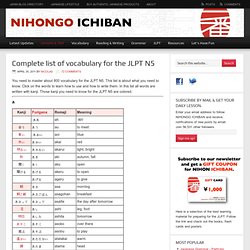
Click on the kanji and watch the video with the stroke order on how to write it and learn from example vocabulary. When you click the “Share” button on top of the page you can also select to print in a printer friendly view (in total 31 A4 pages). JLPT Level N5 Resources - Free vocabulary lists and MP3 sound files. Products I think are awesome: If you're a bit shakey on your hiragana and katakana, try writing them over and over until they stick.
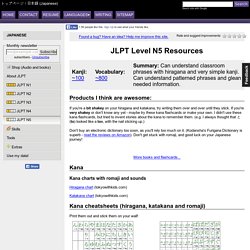
If you're very shakey or don't know any yet - maybe try these kana flashcards or make your own. I didn't use these kana flashcards, but tried to invent stories about the kana to remember them. (e.g. I always thought that と (to) looked like a toe, with the nail sticking up.) JGram - The Japanese Grammar database. Japanese Language Stack Exchange. Learn Japanese Forum - Kunyomi or Onyomi?!?!? You can't really be 100% sure, but lately I do guess right of most of the time with characters I know well. When you look them up afterwards, it helps you remember them very easily if you guessed them right. If you think about looking up a difficult English word, it's not always easy to know how to pronounce it (which parts are stressed in particular) just by reading it, so it's not just Japanese that's tricky like that. I think teaching yourself kanji like that will create a lot of headaches later down the line.
A lot of difficult characters contain radicals that are characters themselves. Look at 貝 and 斤, and then 質, for example. There are a couple of textbooks that structure a kanji-learning course around this concept. It ignores how to read the characters completely, for reasons that we've explained already: the best way to learn to read... is to read. As for the confidence issue, I'd like to meet somebody who was confident about learning kanji. Nippon VoiceBlog. We offer Kagamimochi to God from Ganjitsu, the first day of New Year, to January 11th.
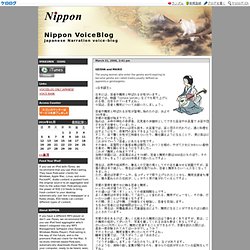
We wish happiness for New Year and decorate it. Kagamimochi is , so to speak, means something for people to open correspondence with gods. 福娘童話集 -世界と日本の童話・昔話集- Embajada de Japón en México. Aprendizaje e intercambio multilingüe de idiomas. Type I, Type II and Type III Verbs. Before we even start to learn verbs, it is important for me to point out that these rules for learning verbs and the changing of forms usually only applies to foreigners or 外人 (gaijin).

My 先生 (sensei) once told me, these rules are created to have those who are not native to the language learn faster and remember them better. Hence, if you are learning Japanese using these rules, please take note that the kids from Japan may not learn it the same way as you. A verb, as we all know, tells us a particular action that we are doing.
In the English language, verbs can be conjugated to mean an action done in the past, present, or the future. However, verbs in the Japanese language can do so much more just by a simple conjugation. Matsukaze Nihongo Annai - aru/arimasu & iru/imasu. ある/あります and いる/います both represent the verb "to be" as in "to exist.
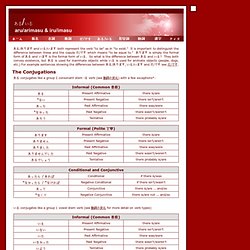
" It is important to distinguish the difference between these and the copula だ/です which means "to be equal to. " あります is simply the formal form of ある and います is the formal form of いる. So what is the difference between ある and いる? They both convey existence, but ある is used for inanimate objects while いる is used for animate objects (people, dogs, etc.) For example sentences showing the differences between ある/あります, いる/います and だ/です see だ/です. The Conjugations. 2001 Waka - Poems Main Menu. Ogura Hyakunin Isshu. Contents Introduction: What is Ogura Hyakunin Isshu?
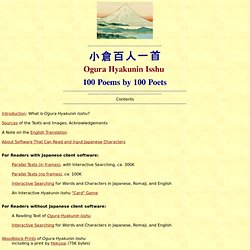
Sources of the Texts and Images; Acknowledgements A Note on the English Translation About Software That Can Read and Input Japanese Characters. Chihayafuru Wiki. Japanese - English Dictionary - sore - Tanoshii Japanese. Learn Japanese Online for Free! Languages - A Guide to Languages - 10 facts, 20 key phrases and the alphabet. Learn Japanese with Free Japanese Lessons - Learn to speak the Japanese language online for free! Japoneando. JGram - The Japanese Grammar database.
Welcome to Japan Language Centre. 和风日语学习网-日语学习,日语在线学习,在线学日语. Japanese Listening Comprehension Exercises. Reading Tutor Homepage. Minna.html. Communication Tools _ Index. アニメ・マンガの日本語 Japanese in Anime & Manga. Instituto Cultural Mexicano Japones A.C. Curso de japonés por libre. Japanese Listening Comprehension Exercises. Japanese verb conjugator. Tae Kim's Japanese guide to Japanese grammar. Japanese Stories. Go to Tom Ray's home page.
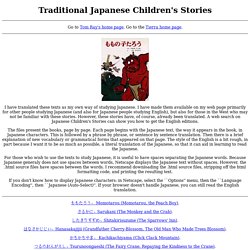
Go to the Tierra home page. I have translated these texts as my own way of studying Japanese. I have made them available on my web page primarily for other people studying Japanese (and also for Japanese people studying English), but also for those in the West who may not be familiar with these stories. However, these stories have, of course, already been translated. A web search on Japanese Children's Stories can show you how to get the English editions. The files present the books, page by page. For those who wish to use the texts to study Japanese, it is useful to have spaces separating the Japanese words. If you don't know how to display Japanese characters: in Netscape, select the ``Options'' menu, then the ``Language Encoding'', then ``Japanese (Auto-Select)''. ももたろう、 Momotarou (Momotarou, the Peach Boy). さるかに、Sarukani (The Monkey and the Crab). したきりすずめ、Shitakirisuzume (The Sparrows' Inn).
Aprende Kanjis como un Japones. LunaVioleta.
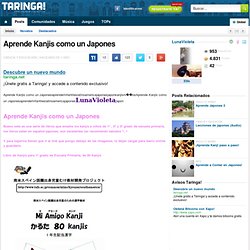
Kids Web Japan. Japanese - Scenario 2 - Ninja to the Rescue! Material didáctico para niños de Suramérica de habla hispana. FUNDACIÓN JAPÓN MADRID. Libros para aprender kanjis de primaria. En japonés. Japanese Graded Reader Volume 1 Volume 3 (e-books and audio) Peso: 120 Mb Año: 2008 Páginas: 85.
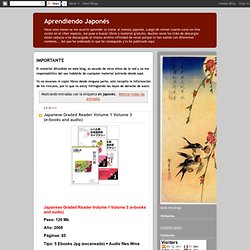
-Chukyu. 1771 Mujeres Wallpapers and Backgrounds Page 40. Time : hours (interactive) Curso de Idioma Japonés 日本語: Diálogos (Lección introductoria 2) Presentarse en Japonés (Esta lección es una introducción que sirve para tener una muestra de como es el idioma y algo de vocabulario. Japanese lesson song-Aisatsu no uta. Contadores y cuantificadores en japonés. Kira-Teachings — Japonés para autodidactas. Hiragana y Katakana. Learn Japanese Adjectives & Adverbs Online Free. 100 Japanese Flash Cards that Go Anywhere you Go Each different card set has about 100 cards.
Cards in the Japanese verbs product feature an illustration and English verb on the front of the card. On the back, the verb is shown in 3 important forms, -masu, -te, and dictionary form, in both Japanese and Roman script. The Japanese adjectives product shows an English adjective or adverb on the front of the card and sometimes its opposite as well as an illustration.
The back of the card shows the Japanese translations of the words. Lesson 01 - Greetings. Kana Invaders! Uso de adjetivos. Añadir el gadget a tu página web. Añadir el gadget a tu página web. Añadir el gadget a tu página web. Los verbos en japonés. Lección 4: Horas, Días de la semana y Meses. Retomamos los números de la Leccion2 (poner el enlace) y aprenderemos a decir las horas, los días de la semana y los meses. Veremos cómo se dicen las horas y los minutos, que no siempre es igual, los días de la semana (no solo en referencia al "de lunes a domingo"), ya entenderéis a que me refiero y los meses, que será lo más fácil. Como fue L el que nos inició con el tema de la hora, ya os lo encontraréis por aquí dando algún consejo. Días, semanas y meses en japonés (日本語 TIPS) Una de las cosas más básicas en un idioma son las fechas. Y el vocabulario para referirse a ciertos días en específico son aspectos escenciales de cualquier idioma.
Contar en Japones de forma divertida. Learn Japanese Hiragana in 90 seconds. Japanese Vocabulary - Days of the week in Japanese. Aprender japonés. Introducción al idioma japonés. よろしく (^O^) LETS LEARN JAPANESE. Juegos para aprender alfabetos del mundo (cursos gratis) Erin's Challenge! I can speak Japanese.